Selim I
Selim I (Ottoman Turkish: سليم اول, Turkish: Birinci Selim; 10 October 1470 – 22 September 1520), known as Selim the Grim or Selim the Resolute[3] (Turkish: Yavuz Sultan Selim), was the Sultan of the Ottoman Empire from 1512 to 1520.[4] His reign is notable for the enormous expansion of the Empire, particularly his conquest between 1516 and 1517 of the entire Mamluk Sultanate of Egypt, which included all of the Levant, Hejaz, Tihamah, and Egypt itself. On the eve of his death in 1520, the Ottoman Empire spanned about 576,900 sq mi (1,494,000 km2), having grown by seventy percent during Selim's reign.[4]
| Selim I | |||||
|---|---|---|---|---|---|
| Ottoman Caliph Amir al-Mu'minin Custodian of the Two Holy Mosques Padishah | |||||
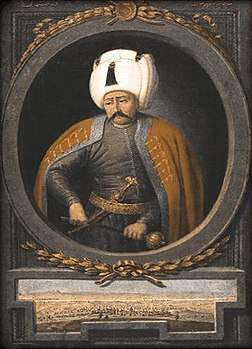 | |||||
| 9th Ottoman Sultan (Emperor) | |||||
| Reign | 24 April 1512 – 22 September 1520 | ||||
| Predecessor | Bayezid II | ||||
| Successor | Suleiman I | ||||
| Prince-Governor of Trebizond Sanjak | |||||
| Reign | 1487 – 1510[1] | ||||
| Born | 10 October 1470 Amasya, Ottoman Empire | ||||
| Died | 22 September 1520 (aged 49) Çorlu, Ottoman Empire | ||||
| Burial | |||||
| Consorts | |||||
| Issue | |||||
| |||||
| Dynasty | Ottoman | ||||
| Father | Bayezid II | ||||
| Mother | Gülbahar Hatun | ||||
| Tughra |  | ||||
Selim's conquest of the Middle Eastern heartlands of the Muslim world, and particularly his assumption of the role of guardian of the pilgrimage routes to Mecca and Medina, established the Ottoman Empire as the most prestigious of all Muslim states. His conquests dramatically shifted the empire's geographical and cultural center of gravity away from the Balkans and toward the Middle East. By the eighteenth century, Selim's conquest of the Mamluk Sultanate had come to be romanticized as the moment when the Ottomans seized leadership over the rest of the Muslim world, and consequently Selim is popularly remembered as the first legitimate Ottoman Caliph, although stories of an official transfer of the caliphal office from the Abbasid Dynasty of Cairo to the Ottomans were a later invention.[5]
Biography
Born in Amasya around 1470, Selim was the youngest son of Şehzade Bayezid (later Bayezid II). His mother was Gülbahar Hatun, a Turkish princess from the Dulkadir State centered around Elbistan in Maraş; her father was Alaüddevle Bozkurt Bey, the eleventh ruler of the Dulkadirs.[6][7] Some academics state that Selim's mother was a lady named Gülbahar,[8] while chronological analysis suggests that his biological mother's name could also have been Ayşe Hatun.[9]
By 1512 Şehzade Ahmet was the favorite candidate to succeed his father. Bayezid, who was reluctant to continue his rule over the empire, announced Ahmet as heir apparent to the throne. Angered with this announcement, Selim rebelled, and while he lost the first battle against his father's forces, Selim ultimately dethroned his father. Selim ordered the exile of Bayezid to a distant "sanjak", Dimetoka (in the north-east of present-day Greece). Bayezid died immediately thereafter.[10] Selim put his brothers (Şehzade Ahmet and Şehzade Korkut) and nephews to death upon his accession. His nephew Şehzade Murad, son of the legal heir to the throne Şehzade Ahmet, fled to the neighboring Safavid Empire after his expected support failed to materialize.[11] This fratricidal policy was motivated by bouts of civil strife that had been sparked by the antagonism between Selim's father and his uncle, Cem Sultan, and between Selim himself and his brother Ahmet.
Conquest of the Middle East
Safavid Empire
.jpg)
One of Selim's first challenges as Sultan involved the growing tension between himself and Shah Ismail, who had recently brought the Safavids to power and had switched the Persian state religion from Sunni Islam to adherence to the Twelver branch of Shia Islam. By 1510 Ismail had conquered the whole of Iran and Azerbaijan,[12] southern Dagestan (with its important city of Derbent), Mesopotamia, Armenia, Khorasan, Eastern Anatolia, and had made the Georgian kingdoms of Kartli and Kakheti his vassals.[13][14] He was a great threat to his Sunni Muslim neighbors to the west. In 1511 Ismail had supported a pro-Shia/Safavid uprising in Anatolia, the Şahkulu Rebellion.
In 1514 Selim I attacked Ismail's kingdom to stop the spread of Shiism into Ottoman dominions. Selim and Ismā'il had exchanged a series of belligerent letters prior to the attack. Selim I defeated Ismā'il at the Battle of Chaldiran in 1514.[15] Ismā'il's army was more mobile and his soldiers better prepared, but the Ottomans prevailed due in large part to their efficient modern army, possession of artillery, black powder and muskets. Ismā'il was wounded and almost captured in battle, and Selim I entered the Iranian capital of Tabriz in triumph on 5 September,[16] but did not linger. The Battle of Chaldiran was of historical significance: the reluctance of Shah Ismail to accept the advantages of modern firearms and the importance of artillery proved decisive.[17] After the battle, Selim, referring to Ismail, stated that his adversary was: "Always drunk to the point of losing his mind and totally neglectful of the affairs of the state".[18]
Syria, Palestine, Egypt and the Arabian Peninsula
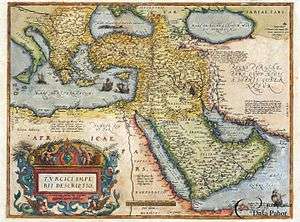
Selim then conquered the Mamluk Sultanate of Egypt, defeating the Mamluk Egyptians first at the Battle of Marj Dabiq (24 August 1516), and then at the Battle of Ridanieh (22 January 1517). This led to the Ottoman annexation of the entire sultanate, from Syria and Palestine in Sham, to Hejaz and Tihamah in the Arabian Peninsula, and ultimately Egypt itself. This permitted Selim to extend Ottoman power to the Muslim holy cities of Mecca and Medina, hitherto under Egyptian rule. Rather than style himself the Ḥākimü'l-Ḥaremeyn, or The Ruler of The Two Holy Cities, he accepted the more pious title Ḫādimü'l-Ḥaremeyn, or The Servant of The Two Holy Cities.[10][19]
The last Abbasid caliph, al-Mutawakkil III, was residing in Cairo as a Mamluk puppet at the time of the Ottoman conquest. He was subsequently sent into exile in Istanbul. In the eighteenth century a story emerged claiming that he had officially transferred his title to the Caliphate to Selim at the time of the conquest. In fact, Selim did not make any claim to exercise the sacred authority of the office of caliph, and the notion of an official transfer was a later invention.[5]
After conquering Damascus in 1516, Selim ordered the restoration of the tomb of Ibn Arabi (d. 1240), a famous Sufi master who was highly revered among Ottoman Sufis.[20]
Death
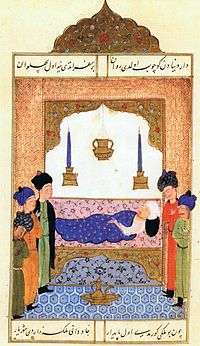
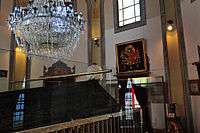
This campaign was cut short when Selim was overwhelmed by sickness and subsequently died in the ninth year of his reign. He was about fifty years of age. Officially it is said that Selim succumbed to sirpence, a skin infection that he had developed during his long campaigns on horseback. (Sirpence was an anthrax infection sometimes seen among leatherworkers and others who worked with livestock.) Some historians, however, suggest that he died of cancer or that his physician poisoned him.[21] Other historians have noted that Selim's death coincided with a period of plague in the empire, and have added that several sources imply that Selim himself suffered from the disease.
On 22 September 1520 Sultan Selim I's eight year reign came to an end. Selim died and was brought to Istanbul so he could be buried in Yavuz Selim Mosque which Sultan Suleiman the Magnificent commissioned in loving memory of his father. Sultan Selim I had conquered and unified the Islamic holy lands. Protecting the lands in Europe, he gave priority to the East, as he believed the real danger came from there.[22][23]
Personality
By most accounts, Selim had a fiery temper and had very high expectations of those below him. Several of his viziers were executed for various reasons. A famous anecdote relates how another vizier playfully asked the Sultan for some preliminary notice of his doom so that he might have time to put his affairs in order. The Sultan laughed and replied that indeed he had been thinking of having the vizier killed, but had no one fit to take his place, otherwise he would gladly oblige. A popular Ottoman curse was, "May you be a vizier of Selim's," as a reference to the number of viziers he had executed.[24]
Selim was one of the Empire's most successful and respected rulers, being energetic and hardworking. During his short eight years of ruling, he accomplished momentous success. Despite the length of his reign, many historians agree that Selim prepared the Ottoman Empire to reach its zenith under the reign of his son and successor, Suleiman the Magnificent.[25]
Selim was also a distinguished poet who wrote both Turkish and Persian verse[26] under the nickname Mahlas Selimi; collections of his Persian poetry are extant today.[25] In 1515, he persuaded by the influential clerics of the realm, issued a decree that imposed death penalty on anyone using a printing press, invented in Germany in 1455, to print books in Turkish or Arabic.[27][28][29][30]
Foreign relations
Relations with Shah Ismail
While marching into Persia in 1514, Selim's troops suffered from the scorched-earth tactics of Shah Ismail. The Sultan hoped to lure Ismail into an open battle before his troops starved to death, and began writing insulting letters to the Shah, accusing him of cowardice:
They, who by perjuries seize scepters ought not to skulk from danger, but their breast ought, like the shield, to be held out to encounter peril; they ought, like the helm, to affront the foeman's blow.
Ismail responded to Selim's third message, quoted above, by having an envoy deliver a letter accompanied by a box of opium. The Shah's letter insultingly implied that Selim's prose was the work of an unqualified writer on drugs. Selim was enraged by the Shah's denigration of his literary talent and ordered the Persian envoy to be torn to pieces.[31]
Outside of their military conflicts, Selim I and Shah Ismail clashed on the economic front as well. Opposed to Shah Ismail's adherence to the Shia sect of Islam (contrasting his Sunni beliefs), Selim I and his father before him "did not really accept his basic political and religious legitimacy,"[32] beginning the portrayal of the Safavids in Ottoman chronicles as kuffar.[33] After the Battle of Chaldiran, Selim I's minimal tolerance for Shah Ismail disintegrated, and he began a short era of closed borders with the Safavid Empire.
Selim I wanted to use the Ottoman Empire's central location to completely cut the ties between Shah Ismail's Safavid Empire and the rest of the world.[34] Even though the raw materials for important Ottoman silk production at that time came from Persia rather than developed within the Ottoman Empire itself,[35] he imposed a strict embargo on Iranian silk in an attempt to collapse their economy.[34] For a short amount of time, the silk resources were imported via the Mamluk territory of Aleppo, but by 1517, Selim I had conquered the Mamluk state and the trade fully came to a standstill.[36] So strict was this embargo that, "merchants who had been incautious enough not to immediately leave Ottoman territory when war was declared had their goods taken away and were imprisoned,"[36] and to emphasize frontier security, sancaks along the border between the two empires were given exclusively to Sunnis and those who did not have any relationship with the Safavid-sympathizing Kızılbaş.[37] Iranian merchants were barred from entering the borders of the Ottoman Empire under Selim I. Shah Ismail received revenue via customs duties, therefore after the war to demonstrate his commitment to their thorny rivalry, Selim I halted trade with the Safavids[36]—even at the expense of his empire's own silk industry and citizens.
This embargo and closed borders policy was reversed quickly by his son Suleyman I after Selim I's death in 1520.[36]
Relations with Babur
Relations with Babur (first Mughal Emperor in Northern India) were initially troubled because Selim provided Babur's arch-rival Ubaydullah Khan with powerful matchlocks and cannons to counter the influence of the Safavids. In 1517, when ordered to accept Selim as his Caliph and suzerain, Babur refused.
In 1519, Selim reconciled with Babur, dispatched Ustad Ali Quli the artilleryman, Mustafa Rumi the matchlock marksman, and many other Ottoman Turks to assist Babur in his conquests. Thenceforth this particular assistance proved to be the basis of future Mughal-Ottoman relations.
Family
- Sons
Selim had at least six sons:
- Suleiman the Magnificent;
- Şehzade Salih (died 1499, buried in Gülbahar Hatun Mausoleum, Trabzon);[38]
- Şehzade Orhan, Şehzade Musa and Şehzade Korkut[39]
- Üveys Pasha;
- Daughters
Selim had at least ten daughters, including;[39]
- Fatma Sultan, daughter of Hafsa Sultan. Married firstly to Mustafa Pasha, married secondly to Kara Ahmed Pasha, married thirdly to Hadım Ibrahim Pasha;
- Hatice Sultan,daughter of Hafsa Sultan. Married to Kapudan Iskender Pasha in 1509, once believed to be a wife of Pargalı Ibrahim Pasha but recent research revealed that such marriage never occurred. She might have secondly married Çoban Mustafa Pasha son of Iskender Pasha. She had at least one daughter.;[40]
- Hafsa Sultan, married firstly to Dukakinzade Ahmed Pasha, she might have secondly married in 1517 to Çoban Mustafa Pasha, son of Iskender Pasha. Had one son Sultanzade Osman Pasha, also known as Kara Osman-sah;[41][42]
- Şah Sultan (buried in Eyüp),[43] married in 1523 to Lütfi Pasha (div.), they had a daughter called Ismihan Hanimsultan[41][42]
- Beyhan Sultan, probably daughter of Hafsa Sultan. Married in 1521 to Ferhad Pasha. She had at least one child, Ismihan Hanimsultan;[41][42]
- Gevherhan Sultan, married Isfendiyaroglu Damad Sultanzade Mehmed Bey.
- Sehzade Sultan, might have married Çoban Mustafa Pasha son of Iskender Pasha. Had at least one daughter
Gallery
- Selim I
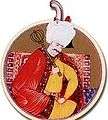 Selim I with a mace
Selim I with a mace Selim in Egypt
Selim in Egypt Selim in court
Selim in court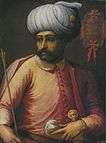 Selim I by an unknown European painter
Selim I by an unknown European painter
Modern day
- The German battlecruiser SMS Goeben was renamed Yavuz Sultan Selim after being handed over to the Turkish Navy in 1914.
- A third bridge over the Bosphorus in Istanbul is called the Yavuz Sultan Selim Bridge. This $3 Billion bridge garnered some criticism as Selim I was known for his ruthlessness, especially against Shi'a muslims.[44]
Popular culture
- Selim I appears as an important character in the action-adventure video game Assassin's Creed: Revelations.
- Selim I is the love interest in the romance novel, The Kadin, written by Bertrice Small.
See also
References
- Hanefi Bostan, XV-XVI. Asırlarda Trabzon Sancağında Sosyal ve İktisadi Hayat, p. 67
- Mansel, Philip (10 November 2011). Constantinople: City of the World's Desire, 1453-1924. p. PT42. ISBN 9781848546479.
- Ágoston, Gábor (2009). "Selim I". In Ágoston, Gábor; Bruce Masters (eds.). Encyclopedia of the Ottoman Empire. pp. 511–3.
- Finkel, Caroline (2005). Osman's Dream: The Story of the Ottoman Empire, 1300-1923. New York: Basic Books. pp. 110–1. ISBN 978-0-465-02396-7.
- Babinger, Franz (1992), Mehmed the Conqueror and His Time, Princeton University Press, p. 57, ISBN 0691010781
- Agoston, Gabor (2011), "The Ottomans: From Frontier Principality to Empire", in Olsen, John Andreas; Gray, Colin S. (eds.), The Practice of Strategy: From Alexander the Great to the Present, Oxford University Press, p. 116, ISBN 978-0140270563
- Yavuz Bahadıroğlu, Resimli Osmanlı Tarihi, Nesil Yayınları (Ottoman History with Illustrations, Nesil Publications), 15th Ed., 2009, page 157, ISBN 978-975-269-299-2
- Dijkema, F.TH (1977), The Ottoman Historical Monumental Inscriptions in Edirne, BRILL, p. 32, ISBN 9004050620
- The Classical Age, 1453-1600 Retrieved on 16 September 2007
- Savory 2007, p. 40.
- BBC, (LINK)
- "History of Iran:Safavid Empire 1502 - 1736". Retrieved 16 December 2014.
- Rayfield, Donald (15 February 2013). Edge of Empires: A History of Georgia. ISBN 9781780230702. Retrieved 15 December 2014.
- Michael Axworthy Iran: Empire of the Mind (Penguin, 2008) p.133
- Housley, Norman (1992). The Later Crusades, 1274-1580: From Lyons to Alcazar. Oxford University Press. p. 120. ISBN 9780198221364. Retrieved 4 March 2020.
- "Morgan, David. Shah Isma'il and the Establishment of Shi'ism". Coursesa.matrix.msu.edu. Retrieved 20 March 2012.
- The pursuit of pleasure: drugs and stimulants in Iranian history, 1500-1900 By Rudolph P. Matthee, pg. 77
- Yavuz Sultan Selim Government Archived 29 September 2007 at Archive.today Retrieved on 16 September 2007
- Burak, Guy (2015). The Second Formation of Islamic Law: The Ḥanafī School in the Early Modern Ottoman Empire. Cambridge: Cambridge University Press. p. 2. ISBN 978-1-107-09027-9.
- Byfeld, Ted, ed. (2010). A Century of Giants. A.D. 1500 to 1600: in an age of spiritual genius, western Christendom shatters. The Society to Explore and Record Christian History. p. 9. ISBN 978-0-9689873-9-1.
- Varlık, Nükhet (2015). Plague and Empire in the Early Modern Mediterranean World: The Ottoman Experience, 1347-1600. New York: Cambridge University Press. pp. 164–165. ISBN 9781107013384.
- Gündoğdu, Raşit (2017). Sultans of the Ottoman Empire. Istanbul: Rumuz Publishing. pp. 262–263. ISBN 9786055112158.
- Dash, Mike. "The Ottoman Empire's Life-or-Death Race". Smithsonian Magazine.
- Necdet Sakaoğlu, Bu Mülkün Sultanları, pg.127
- Bertold Spuler, Persian Historiography and Geography, (Pustaka Nasional Pte Ltd, 2003), 68;"On the whole, the circumstance in Turkey took a similar course: in Anatolia, the Persian language had played a significant role as the carrier of civilization.[..]..where it was at time, to some extent, the language of diplomacy...However Persian maintained its position also during the early Ottoman period in the composition of histories and even Sultan Salim I, a bitter enemy of Iran and the Shi'ites, wrote poetry in Persian."
- "Myths and reality about the printing press in the Ottoman Empire | Daily Sabah". Myths and reality about the printing press in the Ottoman Empire. 8 June 2015. Retrieved 20 May 2020.
- "Origins of Islam's crises". The Friday Times. 19 June 2015. Retrieved 20 May 2020.
- Emre, Suresh (18 January 2014). "On the late adoption of the printing press in the Ottoman Empire". Renaissance Universal. Retrieved 20 May 2020.
- The Rise & Fall of the Muslim Ummah and the Printing Press - Dr. Yasir Qadhi | 4th January 2012, retrieved 20 May 2020
- Crider, Elizabeth Fortuato (1969). The Foreign Relations of the Ottoman Empire Under Selim I, 1512-1520(Master's Thesis). Ohio State University, 1969, page 20. Retrieved on 12 April 2011
- Floor, Herzig, Floor, Willem M, Herzig, Edmund, and Iran Heritage Foundation. Iran and the World in the Safavid Age. International Library of Iranian Studies ; 2. London ; New York: I.B. Tauris, 2012. Chapter 5: The Evolution of Ottoman-Iranian Diplomacy through the Safavid Era. Page 81.
- Floor, Herzig, Floor, Willem M, Herzig, Edmund, and Iran Heritage Foundation. Iran and the World in the Safavid Age. International Library of Iranian Studies ; 2. London ; New York: I.B. Tauris, 2012. Chapter 5: The Evolution of Ottoman-Iranian Diplomacy through the Safavid Era. Page 82.
- Küçükdağ, Yusuf. "Measures Taken by the Ottoman State against Shah İsmail's Attempts to Convert Anatolia to Shia." University of Gaziantep Journal of Social Sciences7, no. 1 (2008). Page 12.
- Floor, Herzig, Floor, Willem M, Herzig, Edmund, and Iran Heritage Foundation. Iran and the World in the Safavid Age. International Library of Iranian Studies ; 2. London ; New York: I.B. Tauris, 2012. Chapter 13: Trade between the Ottomans and Safavids: The Acem Tϋccari and others. Page 237.
- Floor, Herzig, Floor, Willem M, Herzig, Edmund, and Iran Heritage Foundation. Iran and the World in the Safavid Age. International Library of Iranian Studies ; 2. London ; New York: I.B. Tauris, 2012. Chapter 13: Trade between the Ottomans and Safavids: The Acem Tϋccari and others. Page 238.
- Küçükdağ, Yusuf. "Measures Taken by the Ottoman State against Shah İsmail's Attempts to Convert Anatolia to Shia." University of Gaziantep Journal of Social Sciences7, no. 1 (2008). Page 11.
- Şen, Zafer. Yavuz Sultan Selim'in Trabzon'da Medfun Bilinmeyen Kızı Kamer Sultan ve oğlu Şehzade Salih.
- A. D. Alderson (1956). The Structure of the Ottoman Dynasty. Government of India: Department of Archaeology. p. Table XXIX. Selim I and his family.
- Turan, Ebru (2009). "The Marriage of Ibrahim Pasha (ca. 1495-1536): The Rise of Sultan Süleyman's Favorite to the Grand Vizierate and the Politics of the Elites in the Early Sixteenth-Century Ottoman Empire". Turcica. 41: 3–36.
- Şahin, Kaya (2013). Empire and Power in the reign of Süleyman: Narrating the Sixteenth-Century Ottoman World. Cambridge University Press. p. 51. ISBN 978-1-107-03442-6.
- Peirce, Leslie (2017). Empress of the East: How a European Slave Girl Became Queen of the Ottoman Empire. Basic Books. p. 157.
Muhsine, granddaughter of an illustrious statesman, is now largely accepted as Ibrahim's wife.
- Turan, Ebru (2009). The marriage of Ibrahim Pasha (ca. 1495-1536) - The rise of Sultan Süleyman's favourite to the grand vizierate and the politics of the elites in the early sixteenth-century Ottoman Empire. pp. 14, 25.
- Gök, İlhan (2014). II. Bâyezîd Dönemi İn'âmât Defteri ve Ceyb-i Hümayun Masraf Defteri (Thesis). pp. 1464, 1465, 1469.
- Haskan, Mehmet Nermi (2008). Eyüp Sultan Tarihi, Volume 2. Eyüp Belediyesi Kültür Yayınları. p. 535. ISBN 978-9-756-08704-6.
- https://www.k12.wa.us/
Sources

- Savory, Roger (2007). Iran Under the Safavids. Cambridge: Cambridge University Press. ISBN 978-0521042512.CS1 maint: ref=harv (link)
External links

Selim I House of Osman Born: 1470/1 Died: 22 September 1520 | ||
| Regnal titles | ||
|---|---|---|
| Preceded by Bayezid II |
Sultan of the Ottoman Empire 25 April 1512 – 22 September 1520 |
Succeeded by Suleiman I |
| Preceded by al-Mutawakkil III as Caliph of Cairo |
Caliph of the Ottoman Caliphate 1517–1520 |
Succeeded by Suleiman I |
